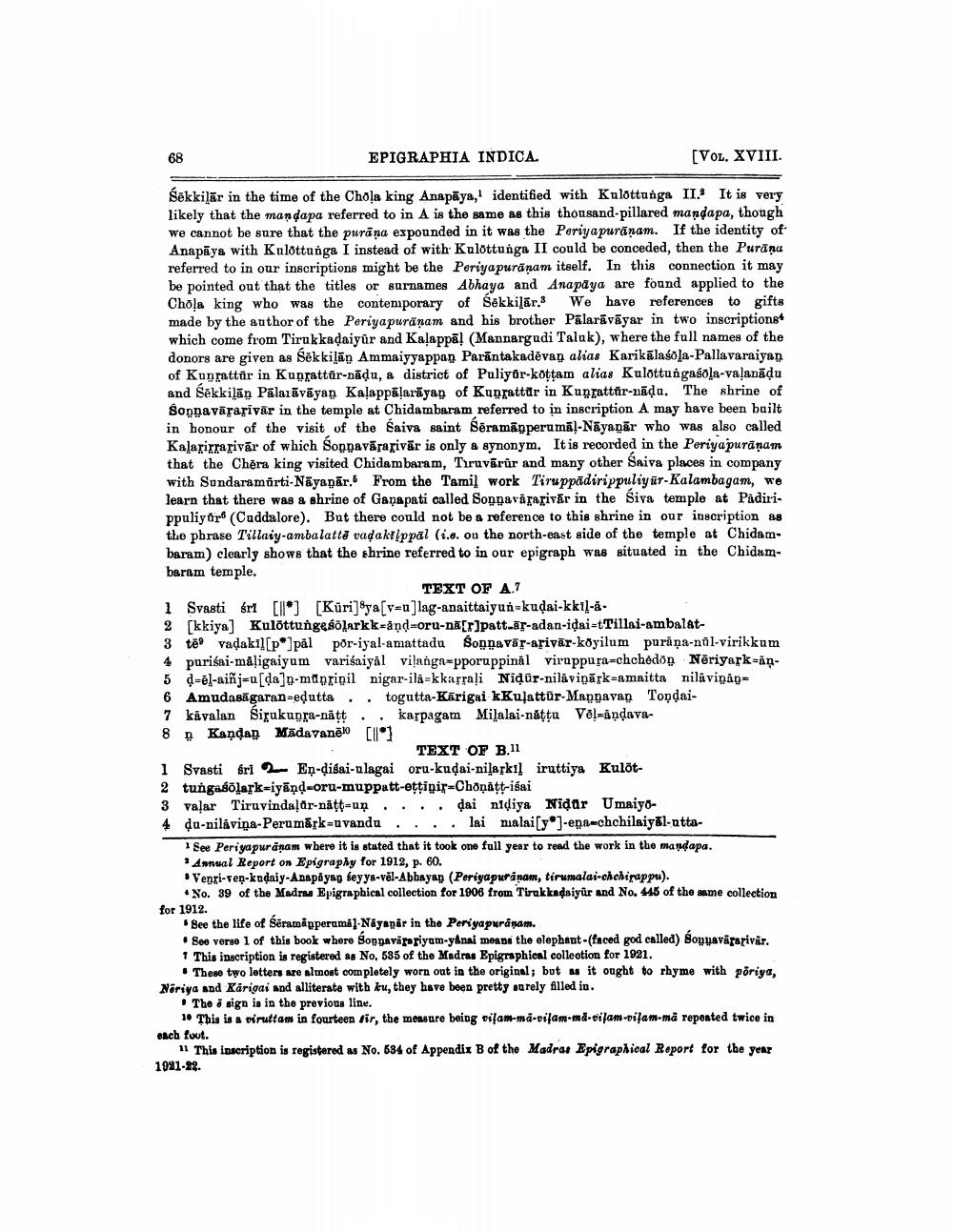________________
EPIGRAPHIA INDICA.
(VOL. XVIII.
Sēkkilar in the time of the Chola king Anapāya, identified with Kulottunga II. It is very likely that the mandapa referred to in A is the same as this thousand-pillared mandapa, though we cannot be sure that the puräna expounded in it was the Periyapurānam. If the identity of Anapāya with Kulottunga I instead of with Kulottunga II could be conceded, then the Purāņu referred to in our inscriptions might be the Periyapurānam itself. In this connection it may be pointed out that the titles or surnames Abhaya and Anapaya are found applied to the Chola king who was the contemporary of Sēkkiļār. We have references to gifts made by the author of the Periyapurānam and his brother Põlarāvāyar in two inscriptions which come from Tirukkadaiyur and Kalappā! (Mannargudi Talak), where the full names of the donors are given as Sēkkilän Ammaiyyappan Parāntakadēvan alias Karikālasola-Pallavaraiyan of Kunrattar in Kupfattär-nādu, a district of Puliyor-kottam alias Kulottungasola-vaļanādu and sēkkilan Palazāvāyan Kalappā arāyap of Kuprattar in Kupfattar-nāda. The shrine of Soppavārarivār in the temple at Chidambaram referred to in inscription A may have been built in honour of the visit of the Saiva saint Sēramāpperumā!-Nāyaṇār who was also called Kalarirrarivār of which Soppavārafivār is only a synonym. It is recorded in the Periyapurānam that the Chēra king visited Chidambaram, Travārür and many other Saiva places in company with Sundaramörti-Nāyaṇār. From the Tamil work Tiruppădirippuliyür-Kalambagam, we learn that there was a shrine of Ganapati called Sopgavāraivār in the Siva temple at Pàdirippuliyor (Cuddalore). But there could not be a reference to this shrine in our inscription 88 the phrase Tillaiy-ambalattd vadaktlppal (i.c. on the north-east side of the temple at Chidambaram) clearly shows that the shrine referred to in our epigraph was situated in the Chidumbaram temple.
TEXT OF A7 1 Svasti sri [I] [Kūri] Sya[v=u]lag-anaittaiyun-kudai-kkil-a2 [kkiya] Kulottungegolarkk-and-oru-nā[r]patt-ar-adan-idait Tillai-ambalat3 tēl vadaki)[p]päl por-iyal-amattadu Soppavār-arivār-köyilum puriņa-nöl-virikkum 4 purisai-maligaiyum varisaiyal vilanga=pporuppinal virappura-chchedop Nēriyark-in5 d-el-aiñ-u[da]n-maprigil nigar-ilaukkarrali Nidūr-niläviņārk-amaitta nilavinan6 Amudas garan-edutta.. togutta-Kārigai kKulattür-Mannavan Tondai7 kävalan Sigukupra-nätt.. karpagam Milalai-năţţu Vél-andava8 Kandan Mädavanēl [ll
TEXT OF B.11 1 Svasti sri 2 En-disai-ulagai oru-kudai-nilarkil iruttiya Kulot2 tungasölark-iyānd-oru-muppatt-ettipir-Choạätt-isai 3 valar Tiruvinda!dr-nått=un.... dai nidiya Nidor Umaiyo4 du-niláviņa-Perumärk=u vandu.... lai nialai[y]-ena=chchilaiyal-atta
1 See Periyapuranam where it is stated that it took one full year to read the work in the mandapa. * Annual Report on Epigraphy for 1912, p. 60. *Venri-ven-kudaiy-Anapayap seyys-vēl-Abhayap (Periyapurinam, tirumalai-chchirappu).
• No. 39 of the Madrus Epigraphical collection for 1906 from Tirukkadaiyur and No. 445 of the same collection for 1912.
See the life of Sēramåpperamal-Niyapir in the Periyapuranam. • See verse 1 of this book where Sondavar riyam-y&nai means the elephant (faced god called) Soppavasarivir. 1 This inscription is registered as No. 535 of the Madras Epigraphical colleotion for 1921.
. These two letters are almost completely worn out in the original; but wit ought to rhyme with põriya, Nöriya and Kärigai and alliterate with keu, they have been pretty surely filled in.
• The o sign is in the previous line.
10 This is a viruttam in fourteen fir, the measure being disam-ma-vifam-md-vifam-vitam-må repeated twice in each fout.
11 This inscription is registered as No. 684 of Appendix B of the Madras Epigraphical Report for the year 1921-22




